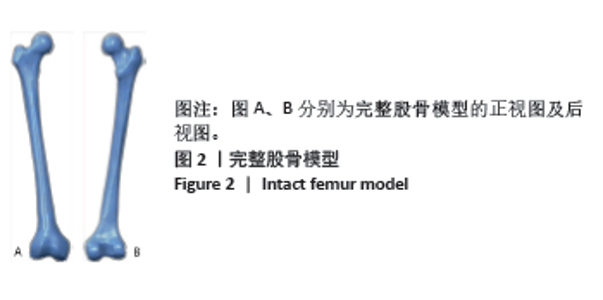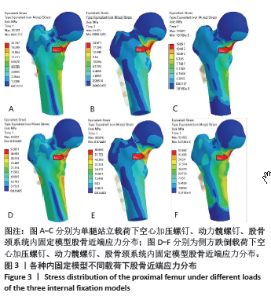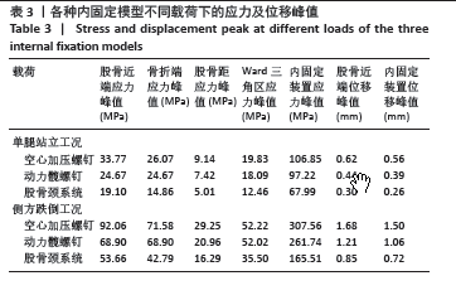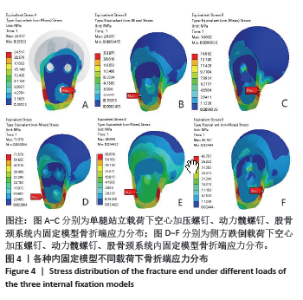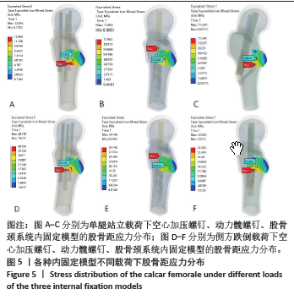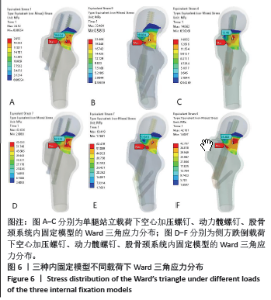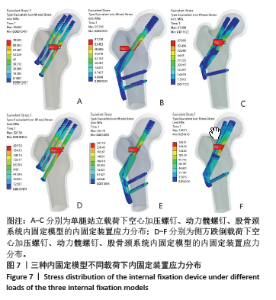Chinese Journal of Tissue Engineering Research ›› 2025, Vol. 29 ›› Issue (3): 455-463.doi: 10.12307/2025.133
Previous Articles Next Articles
Finite element analysis of three internal fixation modalities for treatment of Pauwels type III femoral neck fractures under different loading conditions
Li Zhenggang1, Shang Xuehong1, Wu Zhang2, Li Hong3, Sun Chaojun3, Chen Huadong1, Sun Zhe3, Yang Yi4
- 1Department of Trauma and Orthopedics, First Affiliated Hospital of Dali University, Dali 671000, Yunnan Province, China; 2Department of Orthopedics, First People’s Hospital of Dali, Dali 671000, Yunnan Province, China; 3Department of Joint Surgery, First Affiliated Hospital of Dali University, Dali 671000, Yunnan Province, China; 4Department of Orthopedics, First Affiliated Hospital of Kunming Medical University, Kunming 650032, Yunnan Province, China
-
Received:2023-12-28Accepted:2024-02-04Online:2025-01-28Published:2024-06-03 -
Contact:Yang Yi, Attending physician, Lecturer, Department of Orthopedics, First Affiliated Hospital of Kunming Medical University, Kunming 650032, Yunnan Province, China -
About author:Li Zhenggang, Master, Master’s supervisor, Department of Trauma and Orthopedics, First Affiliated Hospital of Dali University, Dali 671000, Yunnan Province, China Shang Xuehong, Attending physician, Department of Trauma and Orthopedics, First Affiliated Hospital of Dali University, Dali 671000, Yunnan Province, China Li Zhenggang and Shang Xuehong contributed equally to this article. -
Supported by:Construction Project of Yunnan Clinical Medical Center for Osteoarthritis, No. DFYGK005 (to LZG); Discipline Construction Backbone Project of First Affiliated Hospital of Dali University, No. DFYGG2022-21 (to LZG)
CLC Number:
Cite this article
Li Zhenggang, Shang Xuehong, Wu Zhang, Li Hong, Sun Chaojun, Chen Huadong, Sun Zhe, Yang Yi. Finite element analysis of three internal fixation modalities for treatment of Pauwels type III femoral neck fractures under different loading conditions[J]. Chinese Journal of Tissue Engineering Research, 2025, 29(3): 455-463.
share this article
Add to citation manager EndNote|Reference Manager|ProCite|BibTeX|RefWorks
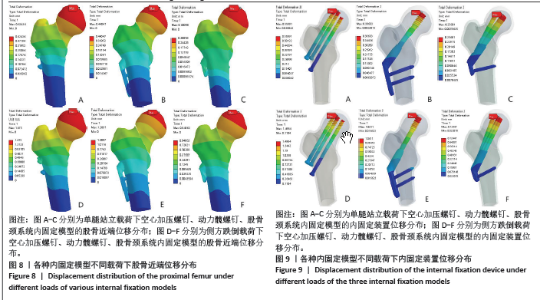
2.7 股骨近端的位移分布及峰值 3种内固定模型在单腿站立及侧方跌倒载荷条件下股骨近端的位移峰值均位于股骨头顶端。单腿站立载荷下空心加压螺钉、动力髋螺钉及股骨颈系统内固定模型的股骨近端位移峰值分别为0.62,0.44及0.30 mm;侧方跌倒载荷下空心加压螺钉、动力髋螺钉及股骨颈系统内固定模型的股骨近端位移峰值分别为1.68,1.21及0.85 mm。两种载荷条件下,空心加压螺钉内固定模型股骨近端位移峰值均为最大,股骨颈系统内固定模型位移峰值均为最小,且各组之间差异范围> 5%。见图8及表3。 2.8 内固定装置的位移及峰值 3种内固定模型在单腿站立及侧方跌倒载荷条件下内固定装置的位移峰值均位于内固定装置上方顶端。单腿站立载荷下空心加压螺钉、动力髋螺钉及股骨颈系统模型的内固定装置位移峰值分别为0.56,0.39及0.26 mm;侧方跌倒载荷下空心加压螺钉、动力髋螺钉及股骨颈系统模型的内固定装置位移峰值分别为1.50,1.06及0.72 mm。两种载荷条件下,空心加压螺钉模型内固定装置的位移峰值均为最大,股骨颈系统模型内固定装置的位移峰值均为最小,且各组之间差异范围> 5%。见图9及表3。"

| [1] JU DG, RAJAEE SS, MIROCHA J, et al. Nationwide Analysis of Femoral Neck Fractures in Elderly Patients: A Receding Tide. J Bone Joint Surg Am. 2017;99(22):1932-1940. [2] LI X, ZHAO L, CHEN R, et al. Effects of total hip arthroplasty and hemiarthroplasty on hip function in patients with traumatic femoral neck fracture. Arch Orthop Trauma Surg. 2023;143(2):873-878. [3] HE C, LU Y, WANG Q, et al. Comparison of the clinical efficacy of a femoral neck system versus cannulated screws in the treatment of femoral neck fracture in young adults. BMC Musculoskelet Disord. 2021;22(1):994. [4] NANDI S. Revisiting Pauwels’ classification of femoral neck fractures. World J Orthop. 2021;12(11):811-815. [5] JUNG CH, CHA Y, CHUNG JY, et al. Trajectory of bolt and length of plate in femoral neck system determine the stability of femur neck fracture and risk of subsequent subtrochanteric fracture : a finite element analysis. BMC Musculoskelet Disord. 2023;24(1):465. [6] SLOBOGEAN GP, SPRAGUE SA, SCOTT T, et al. Complications following young femoral neck fractures. Injury. 2015;46(3):484-491. [7] GAO Z, WANG M, SHEN B, et al. Treatment of Pauwels type III femoral neck fracture with medial femoral neck support screw: a biomechanical and clinical study. Sci Rep. 2021;11(1):21418. [8] ZHONG Z, LAN X, XIANG Z, et al. Femoral neck system and cannulated compression screws in the treatment of non-anatomical reduction Pauwels type-III femoral neck fractures: A finite element analysis. Clin Biomech (Bristol, Avon). 2023;108:106060. [9] ZANI L, ERANI P, GRASSI L, et al. Strain distribution in the proximal Human femur during in vitro simulated sideways fall. J Biomech. 2015;48(10):2130-2143. [10] 郑利钦,林梓凌,李鹏飞,等.动态载荷下松质骨对骨质疏松性股骨颈骨折断裂力学影响的有限元分析[J].中国组织工程研究,2019, 23(12):1887-1892. [11] LOTZ JC, CHEAL EJ, HAYES WC. Stress distributions within the proximal femur during gait and falls: implications for osteoporotic fracture. Osteoporos Int. 1995;5(4):252-261. [12] TAHERI NS, BLICBLAU AS, SINGH M. Comparative study of two materials for dynamic hip screw during fall and gait loading: titanium alloy and stainless steel. J Orthop Sci. 2011;16(6):805-813. [13] MA J, ZHAO Z, ZHI X, et al. Finite element comparative analysis of three different internal fixation methods in the treatment of Pauwels type III femoral neck fractures. BMC Musculoskelet Disord. 2022;23(1):1030. [14] STOFFEL K, ZDERIC I, GRAS F, et al. Biomechanical Evaluation of the Femoral Neck System in Unstable Pauwels III Femoral Neck Fractures: A Comparison with the Dynamic Hip Screw and Cannulated Screws. J Orthop Trauma. 2017;31(3):131-137. [15] 王富洋,刘宇宸,程亮亮,等.股骨颈骨折常用内固定方式的生物力学研究进展[J].中国修复重建外科杂志,2022,36(7):896-901. [16] AUGAT P, BLIVEN E, HACKL S. Biomechanics of Femoral Neck Fractures and Implications for Fixation. J Orthop Trauma. 2019;33 Suppl 1: S27-S32. [17] YANG Y, MACKEY DC, LIU-AMBROSE T, et al. Risk factors for hip impact during real-life falls captured on video in long-term care. Osteoporos Int. 2016;27(2):537-547. [18] 马远征,王以朋,刘强,等.中国老年骨质疏松诊疗指南(2018)[J].中国老年学杂志,2019,39(11):2557-2575. [19] WANG G, TANG Y, WU X, et al. Finite element analysis of a new plate for Pauwels type III femoral neck fractures. J Int Med Res. 2020;48(2): 300060520903669. [20] HUANG S, ZHANG Y, ZHANG X, et al. Comparison of femoral neck system and three cannulated cancellous screws in the treatment of vertical femoral neck fractures: clinical observation and finite element analysis. Biomed Eng Online. 2023;22(1):20. [21] XIA Y, ZHANG W, HU H, et al. Biomechanical study of two alternative methods for the treatment of vertical femoral neck fractures - A finite element analysis. Comput Methods Programs Biomed. 2021; 211:106409. [22] DING K, ZHU Y, ZHANG Y, et al. Proximal femoral bionic nail-a novel internal fixation system for the treatment of femoral neck fractures: a finite element analysis. Front Bioeng Biotechnol. 2023;11:1297507. [23] HELLWINKEL JE, MICLAU T 3RD, PROVENCHER MT, et al. The Life of a Fracture: Biologic Progression, Healing Gone Awry, and Evaluation of Union. JBJS Rev. 2020;8(8):e1900221. [24] DA SILVA MADALENO C, JATZLAU J, KNAUS P. BMP signalling in a mechanical context-Implications for bone biology. Bone. 2020;137: 115416. [25] PAUL GR, VALLASTER P, RÜEGG M, et al. Tissue-Level Regeneration and Remodeling Dynamics are Driven by Mechanical Stimuli in the Microenvironment in a Post-Bridging loadsed Femur Defect Healing Model in Mice. Front Cell Dev Biol. 2022;10:856204. [26] FROST HM. A 2003 update of bone physiology and Wolff’s Law for clinicians. Angle Orthod. 2004;74(1):3-15. [27] CUI H, WEI W, SHAO Y, et al. Finite element analysis of fixation effect for femoral neck fracture under different fixation configurations. Comput Methods Biomech Biomed Engin. 2022;25(2):132-139. [28] BOTTLANG M, DOORNINK J, LUJAN TJ, et al. Effects of construct stiffness on healing of fractures stabilized with locking plates.J Bone Joint Surg Am. 2010;92:12-22. [29] DING K, ZHU Y, LI J, et al. Age-related Changes with the Trabecular Bone of Ward’s Triangle and Neck-shaft Angle in the Proximal Femur: A Radiographic Study. Orthop Surg. 2023;15(12):3279-3287. [30] GAO Z, MA J, WANG Y, et al. Biomechanical evaluation of the reconstruction of the calcar femorale in femoral neck fractures: a coMParative finite element analysis. J Int Med Res. 2022;50(7): 3000605221112043. [31] ZHANG Q, CHEN W, LIU HJ, et al. The role of the calcar femorale in stress distribution in the proximal femur. Orthop Surg. 2009;1(4): 311-316. [32] HAMMER A. The calcar femorale: A new perspective. J Orthop Surg (Hong Kong). 2019;27(2):2309499019848778. [33] TENG Y, ZHANG Y, GUO C. Finite element analysis of femoral neck system in the treatment of Pauwels type III femoral neck fracture. Medicine (Baltimore). 2022;101(28):e29450. [34] HUANG S, ZHANG Y, ZHANG X, et al. Comparison of femoral neck system and three cannulated cancellous screws in the treatment of vertical femoral neck fractures: clinical observation and finite element analysis. Biomed Eng Online. 2023;22(1):20. [35] GUO J, DONG W, YIN Y, et al. The effect of configuration of rhombic cannulated screws on internal fixation of femoral neck fractures. Orthopedics. 2020;43(2):e72-e78. [36] ZHANG Y, YAN C, ZHANG L, et al. Comparison of Ordinary Cannulated Compression Screw and Double-Head Cannulated Compression Screw Fixation in Vertical Femoral Neck Fractures. Biomed Res Int. 2020; 2020:2814548. [37] TIANYE L, PENG Y, JINGLI X, et al. Finite element analysis of different internal fixation methods for the treatment of Pauwels type Ⅲ femoral neck fracture. Biomed Pharmacother. 2019;112:108658. [38] DEKHNE MS, THOMAS HM, HAIDER T, et al. Treatment and outcomes of basicervical femoral neck fractures: A systematic review. J Orthop Surg (Hong Kong). 2021;29(1):23094990211003344. [39] JU FX, HOU RX, XIONG J, et al. Outcomes of Femoral Neck Fractures Treated with Cannulated Internal Fixation in Elderly Patients: A Long-Term Follow-Up Study. Orthop Surg. 2020;12(3):809-818. [40] JIANG X, LIANG K, DU G, et al. Biomechanical evaluation of different internal fixation methods based on finite element analysis for Pauwels type III femoral neck fracture. Injury. 2022;53(10):3115-3123. [41] PENG MJ, XU H, CHEN HY, et al. Biomechanical analysis for five fixation techniques of Pauwels-III fracture by finite element modeling. Comput Methods Programs Biomed. 2020;193:105491. [42] XIA Y, ZHANG W, ZHANG Z, et al. Treatment of femoral neck fractures: sliding hip screw or cannulated screws? A meta-analysis. J Orthop Surg Res. 2021;16(1):54. [43] KEMKER B, MAGONE K, OWEN J, et al. A sliding hip screw augmented with 2 screws is biomechanically similar to an invertedtriad of cannulated screws in repair of a Pauwels type-III fracture. Injury. 2017; 48(8):1743-1748. [44] FAN Z, HUANG Y, SU H, et al. How to choose the suitable FNS specification in young patients with femoral neck fracture: A finite element analysis. Injury. 2021;52(8):2116-2125. [45] WANG Z, YANG Y, FENG G, et al. Biomechanical coMParison of the femoral neck system versus InterTan nail and three cannulated screws for unstable Pauwels type III femoral neck fracture. Biomed Eng Online. 2022;21(1):34. [46] MOON JK, LEE JI, HWANG KT, et al. Biomechanical comparison of the femoral neck system and the dynamic hip screw in basicervical femoral neck fractures. Sci Rep. 2022;12(1):7915. |
| [1] | Xu Hao, Ding Lu, Li Xiao. Investigating the effect of the mechanical wear on abutment screw in Morse taper connection implant implant system by using finite element analysis [J]. Chinese Journal of Tissue Engineering Research, 2025, 29(在线): 1-9. |
| [2] | Li Liangkui, Huang Yongcan, Wang Peng, Yu Binsheng. Effect of anterior controllable anteriodisplacement and fusion on vertebrae-ossification of posterior longitudinal ligament complex and implants: a finite element analysis [J]. Chinese Journal of Tissue Engineering Research, 2025, 29(9): 1761-1767. |
| [3] | Xu Biao, Lu Tan, Jiang Yaqiong, Yin Yujiao. Xu Biao, Lu Tan, Jiang Yaqiong, Yin Yujiao [J]. Chinese Journal of Tissue Engineering Research, 2025, 29(9): 1768-1774. |
| [4] | Zhou Jinhai, Li Jiangwei, Wang Xuquan, Zhuang Ying, Zhao Ying, Yang Yuyong, Wang Jiajia, Yang Yang, Zhou Shilian. Three-dimensional finite element analysis of anterior femoral notching during total knee arthroplasty at different bone strengths [J]. Chinese Journal of Tissue Engineering Research, 2025, 29(9): 1775-1782. |
| [5] | Chen Xi, Tang Tao, Chen Tongbing, Li Qing, Zhang Wen. Mechanical stability of intertrochanteric fracture of femur with different internal fixation systems [J]. Chinese Journal of Tissue Engineering Research, 2025, 29(9): 1783-1788. |
| [6] | Fu Enhong, Yang Hang, Liang Cheng, Zhang Xiaogang, Zhang Yali, Jin Zhongmin. OpenSim-based prediction of lower-limb biomechanical behavior in adolescents with plantarflexor weakness [J]. Chinese Journal of Tissue Engineering Research, 2025, 29(9): 1789-1795. |
| [7] | Huang Haobo, Liang Xinyuan, Ye Guozhong, Xie Qingxiang, Su Boyuan. Suture tape and headless compression screws in treatment of Lisfranc injury with comminuted fractures of the first and second proximal metatarsal bones [J]. Chinese Journal of Tissue Engineering Research, 2025, 29(9): 1803-1809. |
| [8] | Zhang Hao, Wang Qing, Zhang Jian, Li Guangzhou, Wang Gaoju. Comparison of posterior C2-3 fixation combined with bucking bar technique and posterior C2-3 fixation alone in treatment of unstable Hangman fractures [J]. Chinese Journal of Tissue Engineering Research, 2025, 29(9): 1848-1854. |
| [9] | Su Lintao, Jiang Jianfeng, Ma Jun, Huang Liangliang, Lei Changyu, Han Yaozheng, Kang Hui. Precise application of O-arm navigation system in thoracolumbar fractures with developmental pedicle stenosis [J]. Chinese Journal of Tissue Engineering Research, 2025, 29(9): 1855-1862. |
| [10] | Gao Zhenyang, Zeng Xiuan, Yang Qibing, Kou Xianshuai, Wang Kejing, Li Meng. Computer-simulated repositioning combined with pelvic reduction frame for treatment of anteroposterior compression-III pelvic fractures [J]. Chinese Journal of Tissue Engineering Research, 2025, 29(9): 1870-1875. |
| [11] | Sun Xiaojun, Wang Huaming, Zhang Dehong, Song Xuewen, Huang Jin, Zhang Chen, Pei Shengtai. Effect of finite element method in treatment of developmental dysplasia of the hip in children [J]. Chinese Journal of Tissue Engineering Research, 2025, 29(9): 1897-1904. |
| [12] | Lu Jieming, Li Yajing, Du Peijie, Xu Dongqing. Effects of artificial turf versus natural grass on biomechanical performance of the lower limbs in young females during jump-landing [J]. Chinese Journal of Tissue Engineering Research, 2025, 29(6): 1101-1107. |
| [13] | Li Shuai, Liu Hua, Shang Yonghui, Liu Yicong, Zhao Qihang, Liu Wen. Stress distribution on the maxilla when wearing the Twin-block appliance for Class II malocclusion [J]. Chinese Journal of Tissue Engineering Research, 2025, 29(5): 881-887. |
| [14] | Zhou Zonghao, Luo Siyang, Chen Jiawen, Chen Guangneng, Feng Hongchao. Finite element analysis of bioabsorbable plates versus miniature titanium plates in mandibular fracture fixation in different bone qualities [J]. Chinese Journal of Tissue Engineering Research, 2025, 29(4): 818-826. |
| [15] | Chen Yilong, Zhang Xu, Li Hong. Mechanical analysis of fiber post combined with different crown restorations for endodontically treated non-carious cervical lesions [J]. Chinese Journal of Tissue Engineering Research, 2025, 29(4): 866-871. |
| Viewed | ||||||
|
Full text |
|
|||||
|
Abstract |
|
|||||
